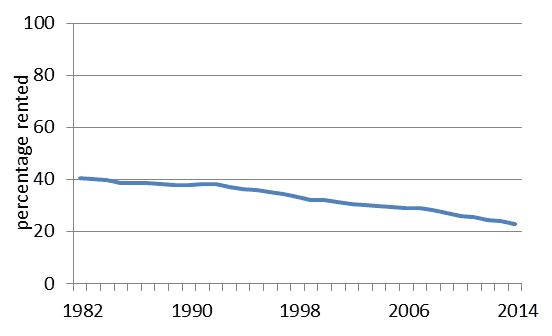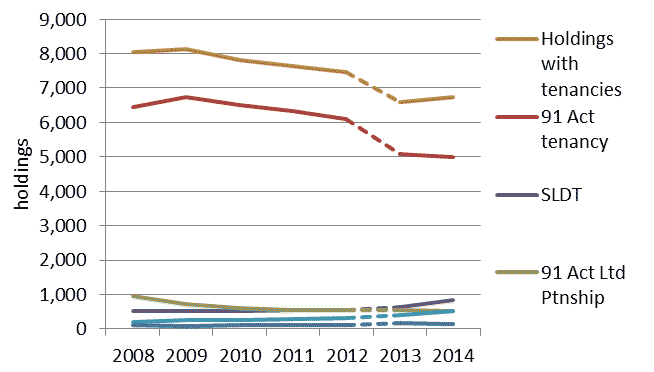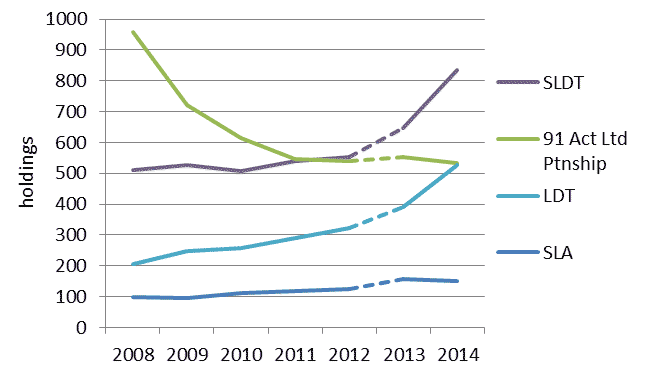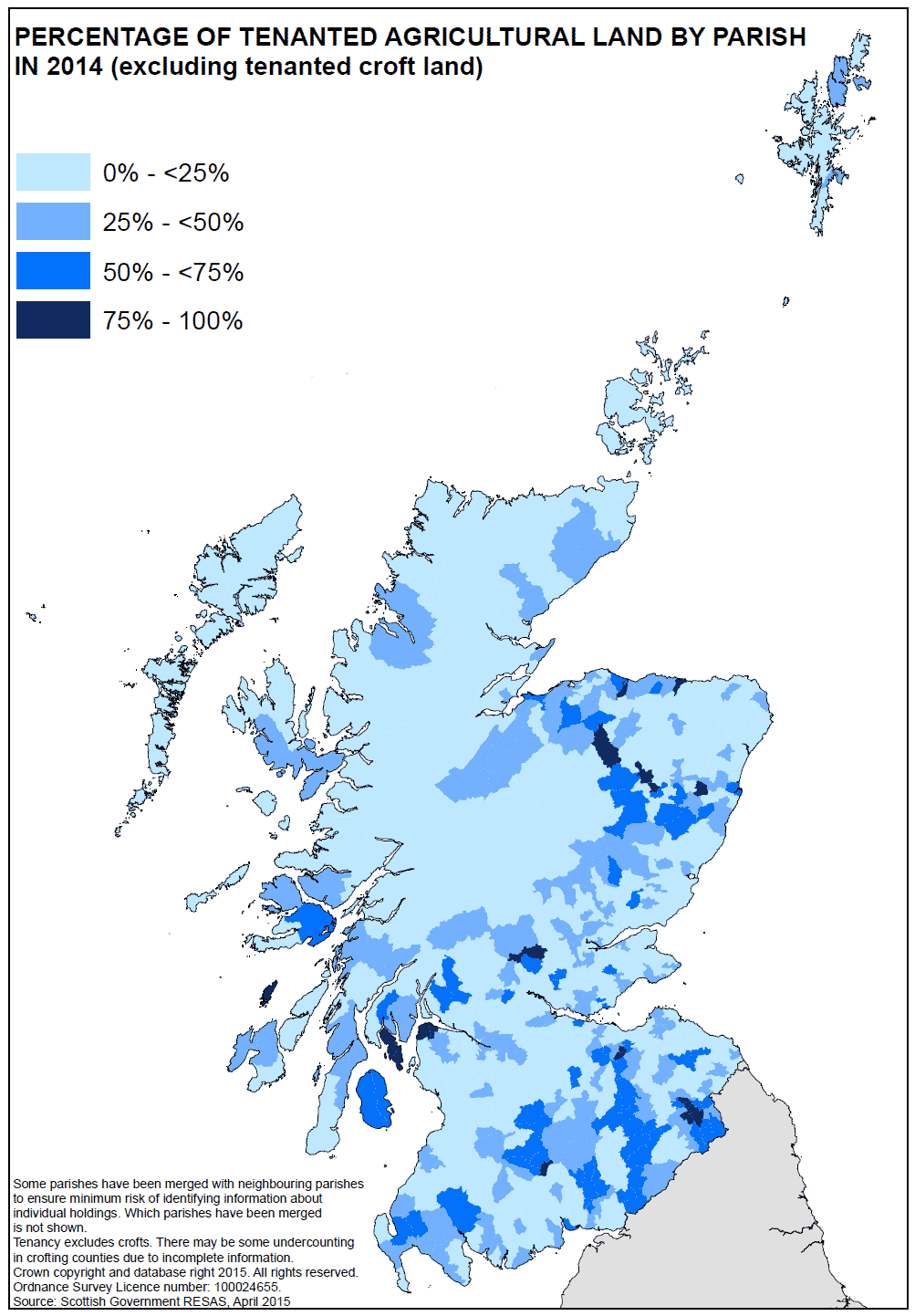Tenanted Agricultural Land in Scotland 2014
Latest statistics of agricultural rents and some data on profitability of tenanted farms
This document is part of a collection
3. Rented land
3.1 Rented area
In 2014 [2] there was a total of 1.33 million hectares recorded as rented under arrangements lasting at least one year, including crofts. This was 23 per cent of agricultural land, or about one sixth of the total area of Scotland.
Chart 1: Percentage of agricultural land that is rented, 1982-2013 source Table 2

While more historical data is recorded on a different basis (a different threshold for farms to be included in the census and a different way of describing the data), the figure has clearly been falling for some time. For example, in the census of 1913, of the 1.94 million hectares of crops and grass, 89 per cent was rented. In 2014, on farms where most land was crops or grass, the proportion of land rented was 23 per cent.
There was a further 770,000 hectares of land rented out on a seasonal basis. In recent years the amount of land let seasonally has increased, but in 2014 there was a fall of 3.5 per cent.
3.2 Types of rental agreement
There are six different types of rental arrangements recorded on the June Agricultural Census. They are:-
- Rented croft (found only in crofting counties defined in legislation)
- Small Landholders Act Tenancy (only found outside crofting counties)
- 91 Act tenancy: Any tenancy for one year or more with full security of tenure and succession rights.
- 91 Act, Ltd Partnership: Any tenancy for one year or more where the tenant is in a limited partnership.
- Short Limited Duration Tenancy (SLDT): entered into for between one and five years duration.
- Limited Duration Tenancy (LDT): entered into on or after Martinmas (28th November) 2003 for ten years or more and with a specific end date.
In 2014 there were 16,760 holdings which reported having rented land. Crofting agreements are based on quite different legal structures, so these are excluded from charts 2a and 2b. Excluding crofts only, there were an estimated 6,725 holdings with full tenancy arrangements. Please note this is the number of holdings with at least one arrangement, not the number of individual tenancies.
Chart 2a: Number of holdings with tenancy arrangements (excluding crofts), 2008-2014 source: Table 3

Work has been done on improving the data for 2013 and 2014, and this will account for some of the changes seen between 2012 and 2013.
Unfortunately the information on the types of tenancies held is not always returned on the census, and it is difficult to gross-up this information based on any other information we have. Various attempts have been made to estimate the number of holdings with each type of tenancy. See the note in section 6.2 on how the figures have been calculated here.
Chart 2a shows that by far the most common tenancy type is a 91 Act tenancy, with three quarters of holdings with tenancies (excluding crofts) having at least one. This number has been decreasing, both in absolute numbers and in the proportion of holdings with tenancies, since 2009.
Chart 2b shows the detail of the lower section of chart 2a. 91 Act Ltd Partnerships were, until 2011, the next most common, but saw a sharp decline after 2008, and have now been overtaken by the number of Short Limited Duration Tenancies.
Chart 2b: Number of holdings with tenancy arrangements (excluding crofts), 2008-2014 (showing detail of lower section of chart 2a) source: Table 3

Crofts are subject to specific legislation (Crofters' (Scotland) Act, 1993) and only exist in specified Crofting Counties (Shetland, Orkney, Caithness, Sutherland, Ross-shire, Inverness-shire and Argyll), plus some newly designated areas from 2010 in Arran, Bute, Greater and Little Cumbrae, Moray and Highland . According to Crofting Commission data in 2014 there were 14,474 tenanted crofts. Please note that the total number of holdings with rented land (16,760) does not equal the 14,474 crofts plus 6,725 other tenancy holdings, as some holdings comprised several crofts, or a mixture of croft and other tenancies.
Anecdotally, and in some of the data, there also appears to be a large amount of land let without any formal arrangements. This may take the form of land swaps, payment in kind, or land being farmed by the tenant with the owner claiming subsidies. About nine per cent of rental arrangements were reported as "payment in kind". These have been excluded from the analysis in section 5.
The following map illustrates the geographic distribution of tenanted land, though note that in some cases parishes have been merged so as not to disclose information about individual holdings.

Contact
Email: Mal Cooke
There is a problem
Thanks for your feedback